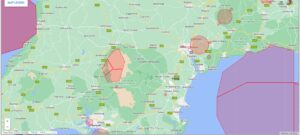The Law
The BMFA Quick Start Guide provides a concise summary of the legislation and Article 16.
UK airspace governing body, the Civil Aviation Authority (CAA) explain what you need to do before you can fly a drone or model aircraft in their Drone and Model Aircraft Code. The terms Drone or Unmanned Aerial Vehicle (UAV), are used to describe all types of unmanned aircraft including free flight, and RC fixed wing aircraft, gliders and drones.
The Code, known as Article 16, covers everything you need to know to make sure you fly your unmanned aerial vehicle safely and legally. It also provides all the information you need to pass the test for a flyer ID, which you need if you want to fly a drone or model aircraft in the UK.
If you operate a model aircraft or drone (weighing more than 250g) outdoors, then you must be registered with the CAA and be able to provide documented evidence of competency. The BMFA (British Model Flying Association) has agreed with the CAA, a very simple process to help members comply including an online Competency Test. BMFA have provided a one stop website for all the information you may need to ensure you are flying safely and lawfully Here. To fly a model aircraft you must obtain a Flyer ID and if you are the owner of the aircraft you must also obtain an Operator ID and display it on your aircraft.
It is against the law to fly a drone or model aircraft without having the required IDs. You may be fined for breaking the law when flying.
Additionally there may be bylaws at other sites such as no powered flight (electric or I.C) within the Dartmoor National Park.
Airports and Airfields
It is illegal to fly unmanned aerial vehicles, such as drones and model aircraft within the Flight Restriction Zone of any UK airport or airfield without the appropriate permissions. The shaded areas on the map below are no fly zones. The location of DSSC is shown on the map just outside of Teignmouth.

Insurance
If you fly a drone or model aircraft for recreation, sport, or as a hobby, you can choose whether or not to have insurance. If you fly for any other reason, you must have third party insurance. Becoming a member of the BMFA automatically provides insurance.
Safe Model Flying
The first thing we need to mention is that every pilot is responsible for the flight they are about to have. They must be in no doubt that the flight can be carried out safely. Any doubt’s you must not fly. Recheck, get help and advice. Know your limitations, fly safely and responsibly.
Safety has always been very important. however these days many models are heavier, faster and in our club generally have a propeller. Added to that the site at LH has limited open space and therefore we need to pay attention to the general public, and safe model/person separation during arrival, preparation, launch, flight and landing. Please also refer to the club Site Rules Nov 2024
Our model pit area at Little Haldon should be a good distance away from the runway at least 10 metres better if 30m.We know this may be difficult to achieve as we have limited space. Pilots or helpers will need to carry their models to the runway. Pilots or helpers should not put their models, gear or chairs next to the take off/ landing area. Maintain a good sized gap where you can prepare the models and or chat to fellow members.
Incident Reporting & BMFA
A number of incidents have happened since coming out of lockdown such as crashing into the pit area, crashing outfield etc. Safety must be our priority to each other and to the public who could be anywhere walking around L/H visible or out of view. We are all here to enjoy ourselves but please review what you are doing and how you fly. You may be unaware that you are making other members uneasy or even scared when you fly. Remember things can go wrong at any time even if you have done thorough checks at home or whilst at the flying site. Use best practice at all times and be prepared for any eventuality.
The BMFA Article 16 Authorisation includes a requirement for remote pilots to report certain accidents, serious incidents and other occurrences to the Air Accident Investigation Branch (AAIB) and the Civil Aviation Authority (CAA). This was an existing requirement, but has been emphasised in the terms of the BMFA Authorisation.
If you have been involved in an incident and are not sure whether it is a reportable occurrence, or who to report the occurrence to or you need to report an occurrence, you should immediately visit the new BMFA Reporting portal at https://reporting.bmfa.uk We (DSSC) emphasis that it is the pilots legal responsibility to report an incident and not the club.
For BMFA guidance about mandatory occurrence reporting see https://rcc.bmfa.uk/art16-occurrence-reporting
BMFA Members completing and submitting this online pre-reporting form will be guided through the correct process and the occurrence will be reported to the necessary bodies.
Although it is not a legal requirement, any significant incident (an occurrence with the potential to cause injury or damage to property) should also be reported to the committee so that it can be investigated to see how safety can be improved.
_______________________________________________
documents will be collated on a separate page
Guidelines are in the BMFA Handbook which you should all be familiar with. In particular the following sections are important to safety.
Safe Flying Everyone.
Dartmoor Slope Soaring Club